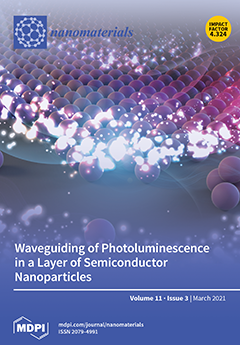Open AccessArticle
Mesoporous Iron(III)-Doped Hydroxyapatite Nanopowders Obtained via Iron Oxalate
by
Margarita A. Goldberg, Marat R. Gafurov, Fadis F. Murzakhanov, Alexander S. Fomin, Olga S. Antonova, Dinara R. Khairutdinova, Andrew V. Pyataev, Olga N. Makshakova, Anatoliy A. Konovalov, Alexander V. Leonov, Suraya A. Akhmedova, Irina K. Sviridova, Natalia S. Sergeeva, Sergey M. Barinov and Vladimir S. Komlev
Cited by 24 | Viewed by 3648
Abstract
Mesoporous hydroxyapatite (HA) and iron(III)-doped HA (Fe-HA) are attractive materials for biomedical, catalytic, and environmental applications. In the present study, the nanopowders of HA and Fe-HA with a specific surface area up to 194.5 m
2/g were synthesized by a simple precipitation
[...] Read more.
Mesoporous hydroxyapatite (HA) and iron(III)-doped HA (Fe-HA) are attractive materials for biomedical, catalytic, and environmental applications. In the present study, the nanopowders of HA and Fe-HA with a specific surface area up to 194.5 m
2/g were synthesized by a simple precipitation route using iron oxalate as a source of Fe
3+ cations. The influence of Fe
3+ amount on the phase composition, powders morphology, Brunauer–Emmett–Teller (BET) specific surface area (S), and pore size distribution were investigated, as well as electron paramagnetic resonance and Mössbauer spectroscopy analysis were performed. According to obtained data, the Fe
3+ ions were incorporated in the HA lattice, and also amorphous Fe oxides were formed contributed to the gradual increase in the S and pore volume of the powders. The Density Functional Theory calculations supported these findings and revealed Fe
3+ inclusion in the crystalline region with the hybridization among Fe-3d and O-2p orbitals and a partly covalent bond formation, whilst the inclusion of Fe oxides assumed crystallinity damage and rather occurred in amorphous regions of HA nanomaterial. In vitro tests based on the MG-63 cell line demonstrated that the introduction of Fe
3+ does not cause cytotoxicity and led to the enhanced cytocompatibility of HA.
Full article
►▼
Show Figures






